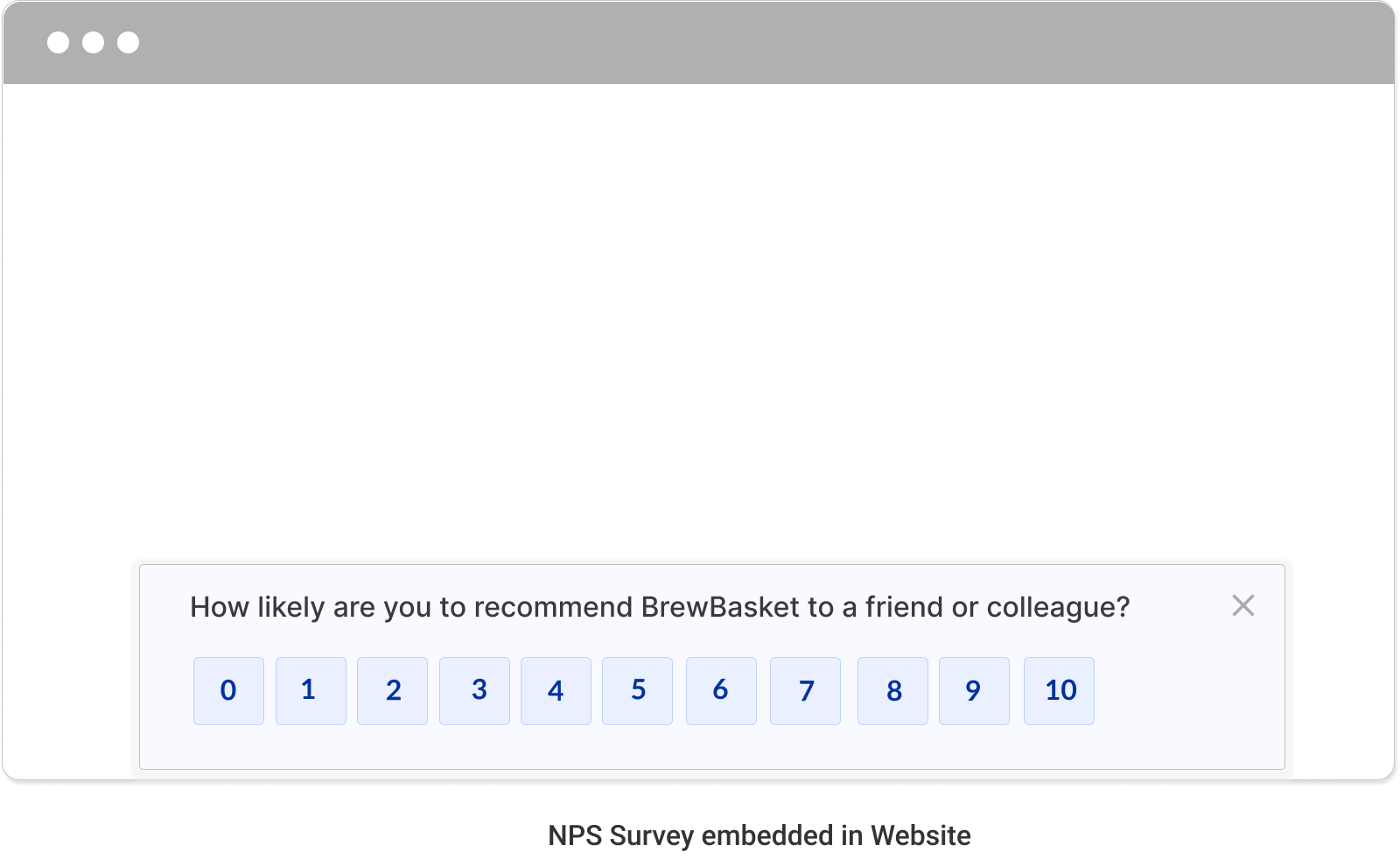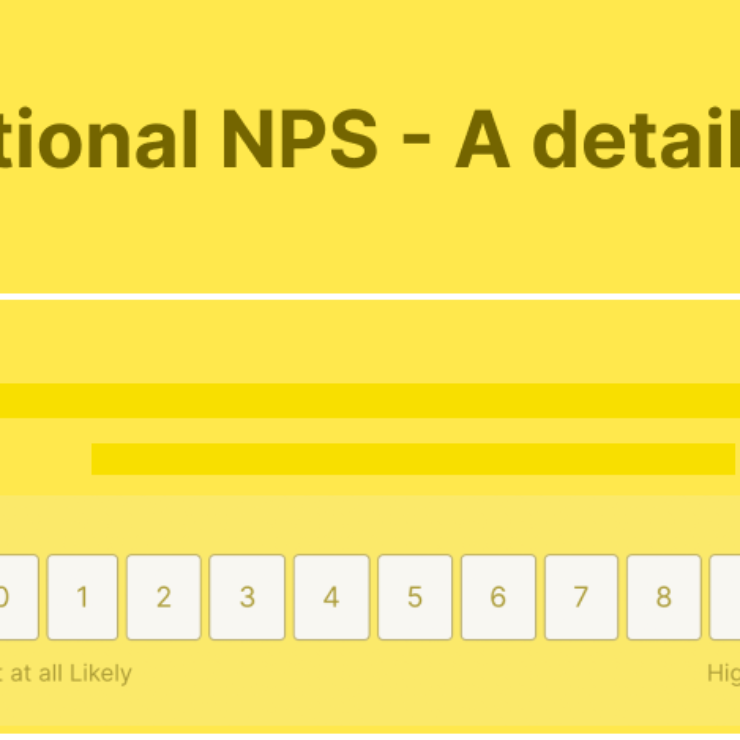Last updated on:
Summary
How to Calculate NPS? The answer is might seem simple. Just use the NPS formula.
Yes, you just need to use the NPS formula, which is : % Promoters – % Detractors.
But is that all? Not really. There are some pre-procedures and post-procedures that you need to follow to calculate NPS and make the most of it. Read to find out.
With increasing popularity, more and more companies are adopting the net promoter score system. And it’s all for a reason. The net promoter system has helped zillions of companies grow exponentially by enhancing customer experience, increasing loyal customers, and boosting the customer retention rate. So, now if you are trying to adopt the NPS system, then we’d say you are definitely on the right track. Knowing the overall NPS score of your company and improving by keeping it as a benchmark can help incredibly.
So, how do you know what your NPS score is? How do you calculate NPS? No worries. It is as simple as it gets. But, before delving into the net promoter calculation and its formula, it’s important to know certain facets of the NPS system.
Things to Do Before Starting with the NPS Calculation
NPS revolves around one basic question, “ On a scale of 0-10, how likely are you to recommend our product/service to your friends and family?”
Your respondents will score you in the range of 0 – 10, and accordingly, you will have to first group them into 3 categories namely; Promoters, Detractors, and Passives, before you calculate the NPS.
So, what do these 3 categories represent?

Promoters: Respondents who scored your 9 or 10. They are your loyal customers who are extremely happy with your product/service.
Passives: Respondents who scored you 7 or 8. They are kind of satisfied with your services but don’t expect them to be loyal as they can switch to your competitors for a better offer.
Detractors: Respondents who scored you in the range of 0 – 6. They are dissatisfied with your services and you are at the risk of losing them. This is the group that’ll need your immediate attention.
Now, that we have grouped our respondents into categories, we can get straight to the NPS calculation formula.
How to calculate NPS: The Formula
As mentioned earlier, the NPS formula is no rocket science! All you have to do is this.
Find out the total number of detractors and promoters, and then their respective percentages. Then just subtract the percentage of detractors from the percentage of promoters.
So, the NPS formula is: %Promoters -%Detractors
For example, you procured 100 responses for your NPS survey. You have a total of 70 promoters and 20 detractors. Now, you have 70% promoters and 20% detractors.
3 Main Methods to Calculate NPS
Taking a tally of the promoters and detractors and calculating the NPS manually, is possible only to a certain extent. If you have just started off and your customer count is anywhere below, let’s say 15, you can go for the manual method of NPS calculation. But calculating NPS for anything above 15 is going to be a herculean task.
When that’s the case, you can go for these 3 other methods which we have mentioned below.
1. Compute with an NPS Calculator
An online NPS calculator can help you calculate your NPS score in seconds. If you have got a count of the number of responses, detractors, and promoters, you can easily find the net promoter score. However, the prerequisites will depend on the specific NPS calculator you use. In some cases, you will be asked to input the number of promoters, detractors, and passives. Here too, there are limitations. As your customer base grows, it is not going to be easy to find the count of passives or detractors.
Want to know what your NPS score is? Find it right away. Here’s a free NPS calculator for you.
Simple NPS Calculator
2. Use an Excel/Google Sheet to Calculate NPS
You can use excel or google sheets to calculate NPS as well. The COUNTIF function in excel can help you in the calculation of NPS. The COUNTIF function gives you the right count of cells that complies with the criteria you apply. As you guessed, we will be employing this function to find the number of promoters and detractors. Now, let’s see how to calculate NPS in excel/google sheets:
Firstly, you need to export the data of your NPS survey to a .CSV or .XLS file. Once that’s done, copy the data from the file onto an excel sheet. Now, you have got to find the total number of detractors and promoters. Let’s say all the scores are contained in column C. So, the function will be:
- COUNTIF (C: C,”>=9”) – Promoters
- COUNTIF (C: C,”<=6”) – Detractors
- COUNTIF (C: C,”=7”) + COUNTIF (C: C,”=8”) – Passives
You are free to apply this function to any of the cells except the ones that belong to the column that consists of the NPS scores. In this case, it will be column C. Now the NPS calculation is almost done. You continue the calculation and find the NPS in two ways now, depending on the data set.
If you have a smaller data set, you can just find the percentage of detractors and subtract it from the percentage of promoters, i.e you can apply the NPS formula here. When you have a larger data set, then you can use a single formula to find the net promoter score in excel:
ROUNDUP((100*((COUNTIF(C:C,”>8″)-COUNTIF(C:C,”<7″))/COUNT(C:C))),0)
Apply the formula and you are done. You’ve calculated your NPS score in excel/ google sheet.
3. Use an NPS tool [ The Best Method]
Without a shadow of a doubt, we can say that using an NPS tool is the best method for NPS calculation. Here’s why it is beneficial.
An NPS software has the ability to make the entire process a lot simpler, not just the calculation. From surveying your customers and calculating the scores to finding customer insights and solving their issues, the software automates the entire process.
You can be up-to-speed with the changes happening with each survey and the fluctuations in your NPS score and find insights related to the current trend in minutes.
However, you should be careful while selecting the tool. You should go for a dedicated, intuitive and responsive tool. The survey by itself should look neat and the experience must be smooth for the respondents.
Here’s how the NPS survey looks like in Affiniv:


You can get the overall NPS score calculation along with insights in this dashboard: 
Affiniv can help you maximize the results of your NPS survey and close the loop effectively. This no-code platform helps you create NPS surveys within minutes via pre-built templates, share them over multiple channels, analyze feedback thoroughly, gain insights and configure automated follow-ups. And of course, it helps you calculate NPS, be it finding the count of promoters and detractors or finding the ultimate score, everything is done automatically. That means minimum effort from your side!
How to Assess NPS after Calculation?
Now, you have other questions in mind. What is a good NPS score? Is yours good enough? Or is it a bad NPS score? So, the need is to assess the NPS score after calculation.
You can assess your NPS score via two methods.
- Absolute NPS
- Relative NPS
Absolute NPS
When you assess your NPS using the absolute method, any positive score i.e any score above 0, is considered good. It clearly means you have more promoters. According to Bain and Co;
- NPS < 0 – Not good
- NPS > 0 – Good
- NPS > 25 – Favorable
- NPS > 50 – Excellent
- NPS > 80 – World class
Relative NPS
When it comes to the relative method, your NPS is juxtaposed with that of the average NPS score of your industry. This is particularly to know where you stand in your niche compared to the competitors.
Absolute NPS is a suitable method if you are a young company that just started out and has a small customer base. However, once you start growing the relative method is much more fitting as it helps you benchmark your score against competition and lets you take actions accordingly.
Yet there are many other underlying factors that determine how good your NPS score is. Click to know what a good NPS score should be and how to assess it.
All things said and done, do not forget to benchmark your previous score with the current NPS score. It clearly tells you at what pace you are improving or deteriorating.
Points to Keep in Mind While Calculating NPS
Here are some points to keep in mind while you calculate NPS. Ignoring this can skew your NPS calculation results.
Sufficient Response Rates
Your NPS is meaningless without a sufficient response rate. Imagine you have 100 customers, and only 10 responded. Out of this 10, 8 are promoters and 2 are detractors. But that does not make you a company that is loved by your customers.
90% of the customers haven’t even responded! Who knows, they might not have responded because they are not satisfied with your company. Or they might not have been aware of a survey being sent. The reasons could be any. So, you can’t make a conclusion out of the particular NPS survey.
This is exactly why you need a solid number of responses to base your NPS score on. For B2B companies the response rate should be at least 30% to get a reliable NPS score.
Record only one response per customer
You should count only one response from each customer or else the results will be unreliable. So, make sure you send only one survey to each individual customer and they should be able to give only one score. Now this will depend on the method you use to survey your customers.
NPS Calculation Done. What Next?
Now that you have calculated your NPS score, what are the next set of steps to do to make the most of your NPS program?
Analyze your Net Promoter Score
As we mentioned earlier, you need to analyze how good or bad your NPS score using the absolute or relative method
Identify and Decode Trends
Segment and compare data and analyze visual charts based on age, demographics etc. to identify trends and insights. You can then see how each segment has varied over time.
Close the loop
Without closing the loop all your efforts are meaningless. Analyze customer opinions, address their issues and take necessary actions to close the feedback loop ( do it immediately for detractors!).
Final Thoughts – Keep the Momentum
Calculating the net promoter score is just one step of the entire program. Your NPS program becomes successful only if you conduct surveys, close the loop, and take efforts to keep improving. Some companies make the mistake of conducting NPS programs once in a blue moon, which is not really going to help. You need to conduct NPS surveys at regular intervals like quarterly or half-yearly basis. Only then can you consistently work on your business and improve customer experience.




![What is NPS [Net Promoter Score]: 2026 Guide](https://affiniv.com/wp-content/uploads/2022/10/what-is-nps-blog-banner-scaled-740x740.jpeg)